Christmas in wine country conjures images of spending festive time in Napa or Sonoma, maybe Paso Robles or Santa Cruz County. But how about this year exploring a totally different wine region, like the Alentejo in Portugal?
Right now, Portugal is one of the hottest destinations on the planet, and the Alentejo is only about an hour east of Lisbon (a city so similar to San Francisco, you’ll almost forget where you are). The wines of Alentejo are great; the food is delicious, and the people, like all of the Portuguese, are beyond friendly.
The Alentejo, with its Mediterranean climate, consists of vast plains and rolling hills and is situated south of the Tagus River and north of the Algarve. You’ll discover large cork forests — the Alentejo produces about half of the world’s corks — as well as acres of vineyards growing some of Portugal’s 250 native grape varietals. Here, towns are centuries old and reflect the rich cultural history of previous civilizations. Many of the towns retain the walls that protected them long ago, including Évora — a Unesco World Heritage Site and the capital of Alentejo.
Évora is filled with white-washed houses from the 16th century, narrow cobblestone streets, palaces, convents, monuments, churches (the building of the medieval cathedral was started in the late 1100s), many built in the popular Manueline style of architecture. There are even ruins from a Roman temple.
Wine tourism is immensely popular in the region with more than 60 wineries on the Alentejo Wine Route. Most have extensive programs to engage and educate their guests about their history and their wines. Some also produce olive oil and have restaurants to showcase their wines with high-end gastronomy. Reds predominate, with fewer whites due to the challenge of the hot climate. Visiting charming towns such as Reguengos de Monsaraz and Montemor-o-Novo along the wine trail is a plus. Here’s what my husband and I found.
THE WINERIES
(All have U.S. importers except where noted.)
Herdade do Esporão (about 40 minutes from Évora) produced its first vintage in 1985, though the property and history date to the 15th century. Archeological relics confirm the significance of the site. Today, Esporão is dedicated to preserving the land and forging strong bonds with the community. Sustainability is an integral part of their everyday life in how they farm their grapes and their olives to the materials used in their state-of-the-art buildings.
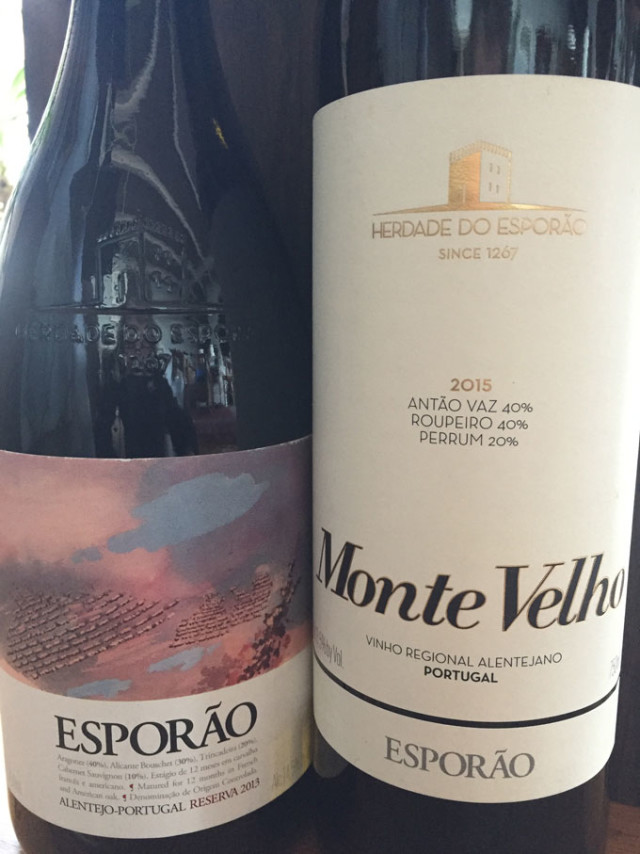
In addition to tours, biking, foraging, bird watching, and wine and olive oil tastings, the restaurant at Esporão is a favorite. The dining room is open and airy and extends to a patio, all overlooking acres of vineyards. The food is expertly prepared, the presentation beautiful; the fresh flavors represent the bounty of their garden and the local products.
Choose your tasting menu and delight in the experience. We started with cured and lightly breaded mackerel in a savory broth of fish bones and tomato water paired with the 2015 Monte Velho White (40 percent Antão Vaz, 40 percent Roupeiro, 20 percent Perrum). Next was the 2015 Reserve White (40 percent Arinto, 40 percent Roupeiro, 20 percent Antão Vaz) served with red mullet, mussels, and squash. The 2013 Reserva Red (40 percent Aragonez, 30 percent Alicante Bouschet, 20 percent Trincadeira, 10 percent Cabernet Sauvignon) was paired with succulent aged beef. The peach and lavender tart for dessert tasted as luscious as it looked (esporao.com/en/).
It’s unusual to have a foundation run a winery, but that’s the business model at Cartuxa. That means the profits from wine and olive oil production go back into running the foundation and contributing to the fabric of the Évora community, including social, educational, agricultural, and cultural projects. Located right outside Évora’s walls, the visitor center was once a refectory in a Jesuit retreat. Now it welcomes thousands of visitors each year to tour the modern interactive facilities, learn more about the history and its sustainability efforts, and taste the wine and olive oil.
Among the wines we sampled from the various labels were the 2013 Pêra-Manca Vinho Branco (70 percent Antão Vaz, 30 percent Arinto) and these 2012s: Cartuxa Tinto Reserva (60 percent Alicante Bouschet, 40 percent Aragonez Tempranillo) and the 2012 Cartuxa Tinto Colheita (50 percent Aragonez, 30 percent Alicante Bouschet, 10 percent Alfrocheiro, 10 percent Trincadeira).
At the olive oil mill, the latest technology extracts all of the goodness from each olive. It produces several labels, but our favorite was the grassy, spicy extra virgin Cartuxa, a blend of several green olives (Picual, Arbequina, and Cobrançosa), available online (cartuxa.pt/en/).
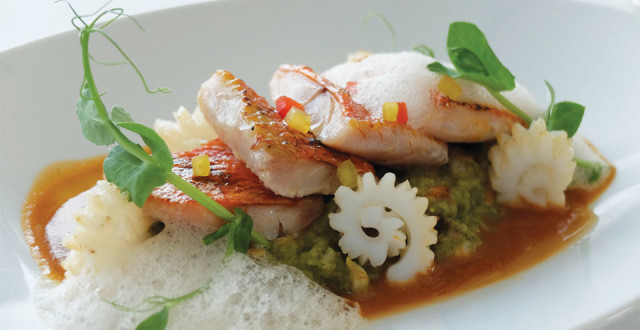
Not far from Esporão, find Carmim, the largest winery in the Alentejo. Originally started by 60 winemakers, the cooperative now boasts more than 900 members who play a vital role in the regional agricultural community. The high-tech facility boasts sophisticated production in the winemaking and richly styled tasting areas (think dark woods, arches and columns, and lots of stone). Only one wine is currently imported to the United States: the 2012 Reguengos DOC Tinto (carmim.eu).
Ervideira is about 20 minutes outside Évora. Currently, there is no U.S. importer, but stop at the cozy wine-country themed tasting room for interesting wines (wonderful.land/ervideira/?lang=en).
At the Rota dos Vinhos tasting room in the heart of Évora, find a wealth of information about the region and winery visits (along the Wine Trail) as well as taste several local brands (vinhosdoalentejo.pt/index.php?lang=en/).
EAT
Évora and the Alentejo region are known for dishes mixing pork with clams and coriander, rustic bread, and fish soups and aromatic herbs. Also popular is lamb stew, black pig, and wild rabbit; local cheeses made from sheep’s milk from a variety of breeds such as Merino, French, and others; and sweets made from lots of egg yolks. Pão (bread) is another favorite, usually quite dense and made into specialty loaves and rolls for each meal. During the holiday season, savor chestnuts roasted in the streets and the Bolo Rei (Portuguese King) cakes.
Just before you get to Évora, make it a point of stopping at L’and Vineyards, one of the Small Luxury Hotels of the World. This ultra-luxe property has an incredible restaurant. The contemporary dining room overlooks the property and is lit with unusual copper fixtures said to resemble the starry Alentejo sky. At lunch, we indulged in an array of local seasonal ingredients perfectly prepared and artistically presented.
The wine at L’and is an important part of the overall experience, but not the driving force at the eco-chic hotel.
The grapes are estate grown, and they bottle a red, white, and rosé (none of which have U.S. importers). The restaurant has an international wine list.
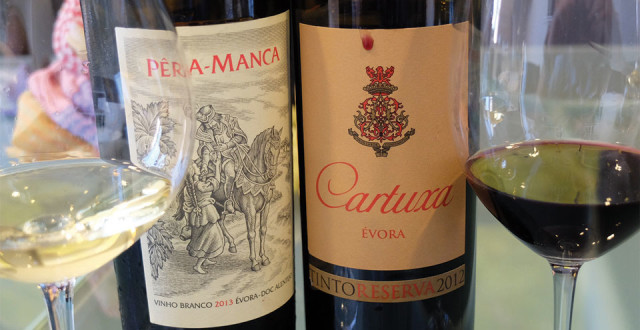
Several amuse bouches whetted our appetites, followed by sumptuous starters — pork terrine under langoustine roe tartar then grilled sardines on an onion cake with an amazing organic tomato salad. Red mullet was the star of the entrée served with a cockle panade and sautéed squid with fish sauce and crispy peppers. Every bite was memorable. Dessert was a knockout: Peaches in lavender syrup and bourbon ice cream (l-and.com).
Located in a historic building near Évora’s wall, Vinoteca Porta de Moura is a unique haven to kick back, enjoy the sounds of jazz and bossa nova, and sample wines and foods distinct to the Alentejo. Like a private home, find comfortable seating areas with oversized chairs and sofas and an intimate outdoor patio space.
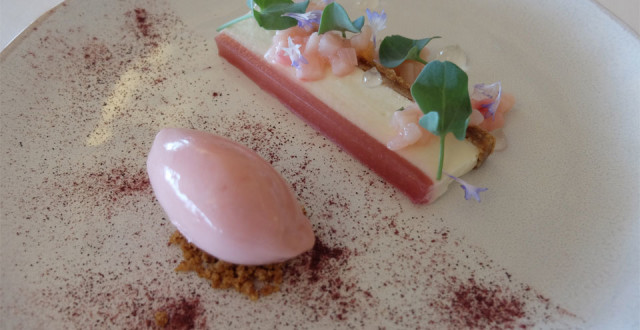
Experience the flavors of the region by trying petiscos (tapas) made with local breads, black pig, grilled sausages, prosciutto, mussels with garlic and coriander, smoked salmon, and plates of meats and cheeses. Choose from Portuguese wines, including many from the area (facebook.com/
vinoteca.portademoura/).
Another local favorite is Boutequim da Mouraria. Tucked on a side street near the main square, get there early to score one of the few seats in this tiny restaurant. Domingos does it all and will shower you with tasty treats and the hospitality of the Alentejo (facebook.com/Botequim-Da-Mouraria-Évora-1646157175624959).
STAY
Inside the wall, try the Pousada Convento Évora, once a convent, now a high-end hotel. With ample amenities, the refurbished guestrooms were former monks’ cells. Located across from the Roman Temple (pousadas.pt/en/hotel/pousada-evora).
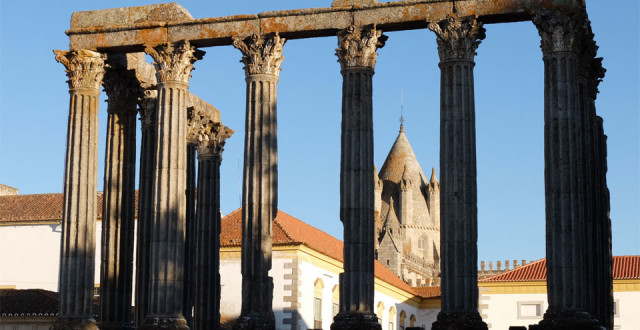
About 20 minutes outside the wall, the Ecorkhotel sits in groves of olive, holm (oak), and cork trees. Aptly named, cork was used in the exterior of the building and works in tandem with the natural heat of the earth and solar panels to be an energy-efficient property. It’s a casual, relaxed environment with modern amenities (ecorkhotel.com/en/eco-hotel-evora).
OTHER ESSENTIALS
Tourism of Portugal: visitportugal.com/en
Wines of Portugal: winesofportugal.info/
Alentejo Tourism: visitalentejo.pt/en/
Small Luxury Hotels of the World: slh.com/




